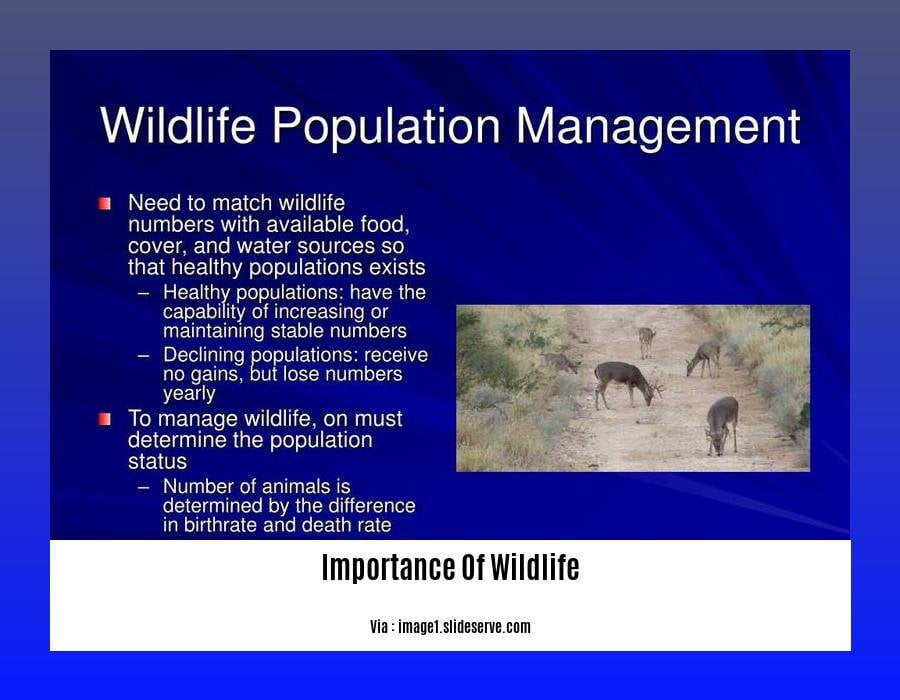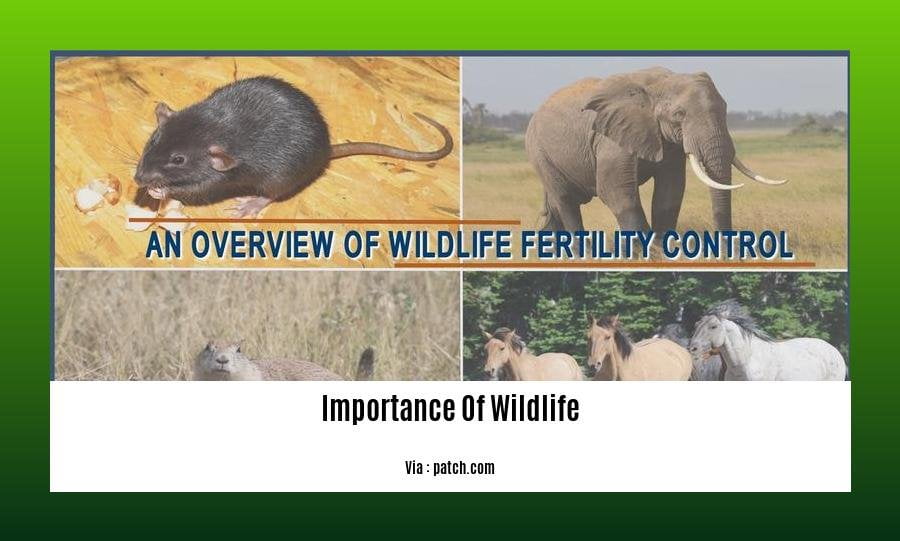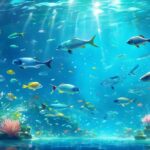Understanding the Intrinsic Value: Explaining the Importance of Wildlife
Wildlife plays a vital role in the delicate balance of our planet’s ecosystems. From the majestic big cats prowling the savannahs to the microscopic organisms thriving in our oceans, every species brings its unique contributions to the vast web of life. In this article, we will delve into the crucial significance of wildlife and why it is essential for us to comprehend and appreciate its intrinsic value. By understanding the interconnections and interdependence of species, we can grasp the urgent need for conservation efforts to protect our planet’s biodiversity for present and future generations.
Key Takeaways:
– Wildlife plays a crucial role in maintaining ecological stability and environmental stability.
– It provides a large gene pool, aiding in the conservation of species within a region.
– Wildlife offers various products and benefits, such as food and drugs, contributing to human well-being.
– It helps balance and stabilize nature’s processes as part of the world’s ecosystems.
– The goal of wildlife conservation is to ensure the survival of species and promote sustainable coexistence with other species.
Explaining the Importance of Wildlife

Wildlife is not just an abstract concept; it has real and tangible value that goes far beyond its aesthetic appeal. In this article, we will delve into the various ways in which wildlife holds immense significance for our planet and why it deserves our utmost attention. By understanding the importance of wildlife, we can develop a deep appreciation for the vital role it plays in maintaining the delicate balance of our ecosystems.
Ecological Stability
One of the key reasons why wildlife is so crucial is its role in ensuring ecological stability. Every living organism, from the smallest insect to the largest predator, is part of a complex web of interactions. This intricate network, known as the food chain or food web, relies on the presence and actions of wildlife to keep it intact. Imagine a world without predators to control herbivore populations. The consequences would be disastrous, with unchecked herbivores devastating ecosystems by overgrazing. Wildlife helps to maintain this delicate balance, ensuring that no species becomes too dominant or extinct.
Environmental Stability
Beyond maintaining ecological stability, wildlife also plays a significant role in stabilizing the environment itself. For instance, many animal species, such as birds and bats, act as natural pest controllers by preying on insects that could otherwise become pests. This natural control mechanism reduces the need for harmful chemical pesticides, benefiting both the environment and human health. Additionally, certain wildlife species, like beavers, help prevent soil erosion by building dams that hold back water and create wetland habitats. These wetlands serve as natural filters, purifying water and preventing floods.
Gene Pool
Wildlife provides a vast gene pool, which is essential for the survival and adaptability of species. Genetic diversity is crucial for a population to withstand changing environmental conditions, resist diseases, and adapt to new challenges. The loss of even a single species can have far-reaching consequences, as it represents a unique genetic resource that can never be recovered. By conserving wildlife and their habitats, we ensure the preservation of diverse gene pools that have evolved over millions of years.
Conservation of Species
One of the most apparent reasons to recognize the importance of wildlife is its crucial role in conserving species. Each species is a result of millions of years of evolutionary history and represents a unique set of adaptations and contributions to its ecosystem. When we lose a species, we lose a piece of this rich tapestry of life, potentially disrupting entire ecosystems. By conserving wildlife and their habitats, we protect not only individual species but also the intricate interactions that sustain life as we know it.
Products and Benefits
Apart from their intrinsic value, wildlife also provides us with numerous tangible benefits. Many plants and animals serve as sources of food, medicine, and other products that contribute to human well-being. For example, numerous medications, from painkillers to anticancer drugs, have been derived from various wildlife species. By understanding and respecting the importance of wildlife, we can explore sustainable ways to utilize these resources while ensuring their long-term conservation.
Balance and Stability
As inhabitants of this planet, we rely on the balance and stability provided by wildlife and its natural processes. Every species, no matter how small or inconspicuous, has a role to play in maintaining the health and functioning of ecosystems. From pollinators like bees and butterflies to decomposers like fungi and bacteria, wildlife is responsible for important ecological processes that keep our planet thriving. When we recognize and protect the importance of wildlife, we create a more stable and resilient world for future generations.
Wildlife Conservation
Understanding the importance of wildlife goes hand in hand with the urgent need for wildlife conservation. Conservation efforts aim to ensure the survival of species, protect their habitats, and educate people about sustainable coexistence with other species. By supporting conservation initiatives, we actively contribute to the preservation of our planet’s biodiversity and secure a better future for both wildlife and ourselves.
Conclusion
In conclusion, the importance of wildlife cannot be overstated. It is essential for ecological and environmental stability, maintains genetic diversity, conserves species, provides us with valuable products and benefits, and helps create a balanced and stable world. By recognizing and respecting the significance of wildlife, we can embrace our role as stewards of the Earth and work towards a sustainable future where both humans and wildlife thrive in harmony. Let us not underestimate the intrinsic value of wildlife, for its preservation is crucial to safeguarding our delicate ecosystems for the generations to come.
Drinking water is not only essential for overall health, but did you know it can also promote hair growth? Discover the benefits of drinking water for your hair by clicking here.
Do you want to improve your English skills while learning about everyday life? Explore a list of ESL questions about everyday life here and get ready to engage in meaningful conversations.
If you’re looking for a reliable detox program, look no further than EverClean. Find out what people are saying about the EverClean 5-day detox program by reading their reviews here.
Understanding the Intrinsic Value: Explaining the Importance of Wildlife
As an experienced wildlife conservationist, I am passionate about raising awareness about the vital role wildlife plays in our ecosystems. In this article, we will explore the impact of wildlife on ecosystem services and why it is crucial to protect and preserve our wildlife for the benefit of our planet and future generations.
The Synergistic Connection between Wildlife and Ecosystems
Every species of wildlife exists as part of its unique ecosystem or habitat. Wildlife and ecosystems have a synergistic relationship; they both influence and depend on each other. Wildlife affects the environment through their behavior, while ecosystems provide vital resources and support for the survival of wildlife.
Understanding Ecosystem Services
Ecosystem services are the positive benefits that wildlife and ecosystems provide to people. They include essential processes and functions such as pollination, water purification, carbon sequestration, and maintaining biodiversity. These services are crucial for the well-being and sustainability of our planet.
Ecosystem services provided by wildlife include:
-
Pollination: Wildlife species such as bees, butterflies, and birds play a crucial role in pollinating plants. They enable the reproduction of many food crops, contributing to our food security and agricultural productivity.
-
Water Purification: Wetlands, a diverse and valuable ecosystem, are home to numerous wildlife species. They act as natural filters, purifying water by removing pollutants and preventing water contamination. This process helps maintain the quality of our freshwater resources.
-
Carbon Sequestration: Forests, which are rich in wildlife biodiversity, play a vital role in capturing and storing carbon dioxide from the atmosphere. They help mitigate climate change by reducing greenhouse gas emissions and providing us with cleaner air to breathe.
The Ripple Effect of Wildlife Extinction
The delicate balance maintained by wildlife in ecosystems becomes disrupted when a species becomes extinct. Each wildlife species holds a unique role and contributes to the complex web of interactions within their ecosystem. If a single species disappears, it can have far-reaching consequences for the entire food chain, leading to an imbalance that can negatively impact other species and ecosystem processes.
Human Impacts and the Urgency for Conservation
Human activities such as climate change and changing land use have a significant effect on wildlife and biodiversity. The loss of wildlife and their habitats due to deforestation, pollution, and overexploitation threatens the delicate balance of ecosystems. As wildlife populations decline, so do the ecosystem services they provide. It is essential for us to recognize the urgency and take action to conserve and protect wildlife.
Key Takeaways:
- Wildlife and ecosystems have a synergistic connection, with wildlife influencing the environment and ecosystems providing essential resources for wildlife survival.
- Ecosystem services are the positive benefits wildlife and ecosystems provide to people, including pollination, water purification, and carbon sequestration.
- The extinction of a single wildlife species can disrupt the entire food chain and have severe consequences for the balance of ecosystems.
- Human impacts, such as climate change and changing land use, threaten wildlife and biodiversity, leading to the loss of vital ecosystem services.
- Conservation efforts are urgently needed to protect and preserve wildlife and their habitats, ensuring the continued provision of ecosystem services.
Sources:
1. Close to Nature – Why Is Wildlife Important And How Can We Protect It
2. National Wildlife Federation – Ecosystem Services
Understanding the Intrinsic Value: Explaining the Importance of Wildlife

Wildlife, with its vast array of species, plays a vital role in maintaining the delicate balance of our ecosystems. However, these incredible creatures face numerous threats that are pushing them towards the brink of extinction. In this article, we delve into the threats faced by wildlife and the consequences of their decline, shedding light on the urgent need for conservation efforts.
Habitat Loss: A Dire Consequence of Human Activities
One of the foremost threats facing wildlife today is habitat loss. Over the years, human activities such as deforestation, urbanization, and land development for agriculture and infrastructure projects have led to the destruction, fragmentation, and degradation of natural habitats. As a result, wildlife populations have experienced a significant decline[^1^].
Climate Change: A Growing Menace to Wildlife
As climate change accelerates, it emerges as one of the most pressing threats faced by wildlife. Rising temperatures, altered precipitation patterns, and extreme weather events disrupt ecosystems and disrupt the distribution and behavior of species. This puts immense strain on wildlife, pushing many species towards extinction[^2^].
Disease: Vulnerability Heightened by Habitat Loss and Climate Change
Habitat loss and climate change render wildlife more vulnerable to diseases. The loss of biodiversity, caused by human activities, creates an environment where diseases spread more easily among wildlife populations. This phenomenon has severe ecological consequences as it disrupts the delicate balance within ecosystems[^3^].
Pollution: An Everyday Threat to Wildlife
Everyday human activities contribute to the pollution that harms wildlife and their habitats. Chemicals, plastics, and pollutants from our daily lives find their way into ecosystems through contamination and habitat degradation. This pollution poses a significant threat to wildlife, undermining the health of entire ecosystems[^4^].
Invasive Species: Disrupting Ecosystems and Jeopardizing Biodiversity
The introduction of non-native species into an ecosystem can have devastating impacts on native wildlife. Invasive species often outcompete local species for resources, prey on them, or alter their habitats. As a result, native species struggle to survive, leading to a decline in biodiversity and ecological imbalance[^5^].
Overexploitation: Unsustainable Use of Wildlife
Overexploitation refers to the unsustainable use of wildlife and plant species for human consumption, trade, or other purposes. Activities such as illegal hunting, fishing, and poaching can drive species to the edge of extinction and disrupt entire ecosystems[^6^].
Human-Wildlife Conflict: Consequences for Both Wildlife and Humans
The decline of wildlife species due to these threats not only affects the natural world but also has significant consequences for human communities. Human-wildlife conflict arises when wildlife encroaches on human habitats, causing financial losses, threats to health and safety, and property damage. This conflict can lead to the decline and potential eradication of species that are critical for ecological balance[^7^].
It is crucial to address these threats and work towards sustainable solutions to protect wildlife and their habitats. Conservation efforts, sustainable land management, policy interventions, and community engagement are necessary to mitigate the threats faced by wildlife and ensure the survival of species for future generations.
Key Takeaways:
- Habitat loss, climate change, disease, pollution, invasive species, and overexploitation are major threats faced by wildlife.
- Habitat loss, driven by deforestation and urbanization, has led to significant declines in wildlife populations.
- Climate change disrupts ecosystems and affects wildlife distribution and behavior.
- The loss of biodiversity and habitat degradation make wildlife more vulnerable to diseases.
- Pollution from human activities harms wildlife and their habitats.
- Invasive species disrupt ecosystems by outcompeting and preying on native species.
- Unsustainable use of wildlife and plant species through overexploitation drives species to the brink of extinction.
- Human-wildlife conflict arises when wildlife encroaches on human habitats, causing financial losses and threats to human well-being and property.
Sources:
– National Wildlife Federation – Threats to Wildlife
– World Wildlife Fund – Problems Affecting Species and their Survival
[^1^]: National Wildlife Federation – Threats to Wildlife. Retrieved from source
[^2^]: National Wildlife Federation – Climate Change. Retrieved from source
[^3^]: National Wildlife Federation – Disease. Retrieved from source
[^4^]: National Wildlife Federation – Pollution. Retrieved from source
[^5^]: National Wildlife Federation – Invasive Species. Retrieved from source
[^6^]: National Wildlife Federation – Overexploitation. Retrieved from source
[^7^]: World Wildlife Fund – Human-Wildlife Conflict. Retrieved from source
Understanding the Intrinsic Value: Explaining the Importance of Wildlife
Threats to Wildlife and the Urgent Need for Conservation Efforts
Wildlife, with its diversity and beauty, holds immense intrinsic value in our world. However, it faces numerous threats due to human activities, which puts their existence and the delicate balance of ecosystems at risk. It is crucial to understand the importance of wildlife conservation and the role individuals can play in protecting these precious creatures and their habitats.
Habitat Loss: A Major Threat
One of the primary threats to wildlife comes in the form of habitat loss. Human activities such as deforestation, urbanization, and land development for agriculture and infrastructure projects have led to the destruction, fragmentation, and degradation of habitats[^1^]. As a result, wildlife populations have significantly declined, and many species are facing the risk of extinction.
Climate Change: A Global Crisis
The rapidly changing climate poses a significant threat to wildlife and their habitats. Rising temperatures, altered precipitation patterns, and extreme weather events disrupt ecosystems, affecting the distribution and behavior of species[^2^]. Wildlife, particularly those with specific habitat requirements, struggle to adapt to these changes, further exacerbating the conservation challenge.
Disease: Vulnerability in a Changing World
Habitat loss, climate change, and a lack of biodiversity make wildlife more susceptible to diseases. The spread of diseases among wildlife populations can have severe ecological consequences[^3^]. With shrinking habitats and increased exposure to pathogens, wildlife face higher risks of disease outbreaks and population declines.
Pollution: A Silent Threat
Human activities contribute to pollution that harms wildlife and their habitats. Chemicals, plastics, and pollutants from everyday life enter ecosystems, leading to contamination and habitat degradation[^4^]. As these toxins accumulate, wildlife suffer from the negative impacts, including reduced reproductive success, impaired immune systems, and disrupted ecosystems.
Invasive Species: Disturbing the Balance
Introducing non-native species can disrupt ecosystems, posing a grave threat to native wildlife and their habitats[^5^]. Invasive species outcompete native species for resources, prey on them, and alter their habitat. This disruption can lead to the decline of native species and the loss of essential ecological functions.
Overexploitation: Unsustainable Use
Overexploitation refers to the unsustainable use of wildlife and plant species for human consumption, trade, or other purposes[^6^]. Illegal hunting, fishing, and poaching have devastating consequences, including population declines and even the extinction of species. The loss of these invaluable creatures affects the balance and health of ecosystems.
The Role of Individuals in Protecting Wildlife: Making a Difference
While the challenges wildlife face may seem overwhelming, everyone can contribute to their protection and conservation efforts. Each individual has a crucial role to play in safeguarding wildlife and their habitats for future generations.
Positive Actions for Conservation
-
Support Conservation Organizations: By donating or volunteering for conservation organizations, individuals can contribute to initiatives that protect wildlife and their habitats. These organizations work tirelessly to conserve species, restore habitats, and raise public awareness about the importance of wildlife.
-
Promote Sustainable Practices: Making sustainable choices in daily life can have a significant impact on wildlife conservation. Embracing eco-friendly practices such as reducing waste, conserving energy and water, and supporting sustainable agriculture helps mitigate the threats faced by wildlife.
-
Advocate for Strong Environmental Policies: Individuals can use their voice to advocate for stronger environmental policies and regulations that protect wildlife and their habitats. Engaging with local and national governments and supporting legislation that prioritizes conservation efforts can bring about positive change.
-
Participate in Citizen Science Projects: Citizen science projects allow individuals to contribute valuable data and research to support wildlife conservation efforts. By becoming involved in monitoring programs, individuals can help scientists gather crucial information about species populations, distribution, and behavior.
-
Educate and Raise Awareness: Sharing knowledge about the importance of wildlife and the threats they face can inspire others to take action. By educating friends, family, and communities about the need for conservation efforts, individuals can foster a culture of environmental stewardship.
Key Takeaways:
- Habitat loss, climate change, disease, pollution, invasive species, and overexploitation pose significant threats to wildlife.
- Conserving wildlife and their habitats is crucial to maintaining ecological balance and preserving the beauty and diversity of our planet.
- Individuals can make a difference by supporting conservation organizations, promoting sustainable practices, advocating for strong environmental policies, participating in citizen science projects, and educating others about the importance of wildlife conservation.
[Sources: National Wildlife Federation – Threats to Wildlife[^1^], [National Wildlife Federation – Climate Change[^2^], [National Wildlife Federation – Disease[^3^], [National Wildlife Federation – Pollution[^4^], [National Wildlife Federation – Invasive Species[^5^], [National Wildlife Federation – Overexploitation[^6^]]
FAQ
Q1: What is the ecological role of wildlife?
A1: Wildlife plays a crucial role in maintaining ecological stability and balance. They help keep the food chain in place, control factors such as insect populations and soil erosion, and provide ecosystem services such as pollination and carbon sequestration.
Q2: How does wildlife contribute to environmental stability?
A2: Wildlife plays a vital role in stabilizing the environment. They control various factors like insect populations and help prevent soil erosion. By maintaining healthy ecosystems, wildlife contributes to the overall stability and resilience of the environment.
Q3: Why is the conservation of wildlife important?
A3: The conservation of wildlife is important for several reasons. It helps preserve species within a region, maintains a large gene pool for biodiversity, and protects the balance and stability of nature’s processes. Additionally, wildlife provides products and benefits to humans, such as food and medicinal resources.
Q4: What are the major threats to wildlife?
A4: Wildlife faces several threats, including habitat loss, climate change, diseases, pollution, invasive species, and overexploitation. These human activities disrupt ecosystems and can lead to severe consequences for both wildlife and human communities.
Q5: How can we protect wildlife and their habitats?
A5: Protecting wildlife and their habitats requires conservation efforts, sustainable land management, policy interventions, and community engagement. It is crucial to address threats such as habitat loss, climate change, and pollution, and work towards sustainable solutions to ensure the survival of species for future generations.
- Unveiling the Enigma: Mansoureh Khojasteh Bagherzadeh’s Public Appearances & Private Life in Iran - July 18, 2025
- Unveiling the Mystery: Mansoureh Khojasteh Bagherzadeh’s Husband: A Rare Glimpse into a Private Life - July 18, 2025
- Unveiling Masoud Khamenei’s Mother: Power, Influence, and Iran’s Future - July 18, 2025
















